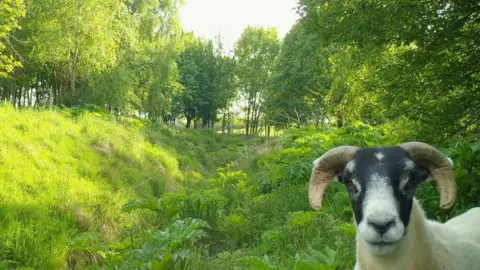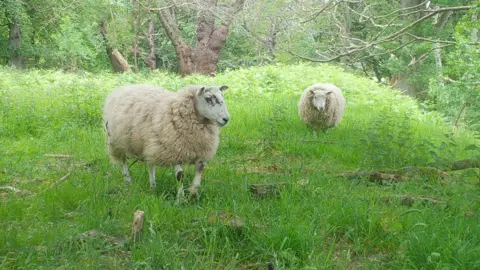Sheep can kill invasive giant hogweed, study suggests
 Scottish Invasive Species Initiative
Scottish Invasive Species InitiativeSheep can help fight the spread of an invasive and highly toxic plant, according to results of a four-year project in Aberdeenshire.
Giant hogweed grows to heights of 5m (16ft) and the sap in its leaves and stems can cause severe skin burns.
It is usually controlled by spraying it with herbicides or by removing flowering heads to prevent the spread of tens of thousands of seeds.
Researchers have found repeated grazing by sheep can kill the plant.
Since 2019, the Scottish Invasive Species Initiative (SISI) has been monitoring sheep in a giant hogweed-dominated area of woodland near the River Deveron at Macduff.
The study suggests the animals' feeding led to the plant's taproot dying off. The researchers found the "woolly warriors" were unaffected by the toxic sap.
SISI said the trial could lead to sheep being used in other places where they could be left to graze safely.
 Scottish Invasive Species Initiative
Scottish Invasive Species Initiative 
Project officer Karen Muller said: "The monitoring undertaken was really important as it allowed us to adjust our grazing regime each year and find the right balance between grazing the giant hogweed and avoiding overgrazing - thereby protecting native plant species.
"We reduced grazing pressure over the first few years and settled on a regime that controlled giant hogweed with limited impacts on native flora."
 Scottish Invasive Species Initiative
Scottish Invasive Species InitiativeLandowner Dan Gordon said amazing progress had been made at the site.
He said: "The giant hogweed was completely dominating the woodland and would have been really tricky and costly to deal with using pesticides.
"The Scottish Invasive Species Initiative provided a very welcome opportunity to try an alternative approach - I'm really pleased with the results."
Giant hogweed is native to Europe's Caucasus Mountains and Central Asia and was introduced as an ornamental plant in British gardens in the 19th Century.
It can spread quickly and each flowering head can produce up to 50,000 seeds.
